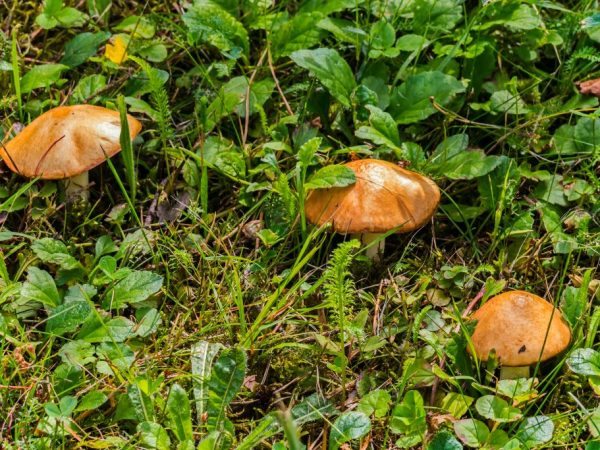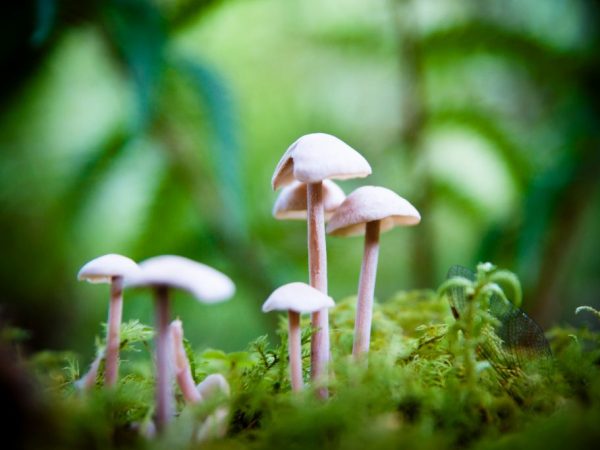Types of mushrooms of the Rostov region
In all regions of Russia, mushroom pickers can find something worthwhile. Mushrooms of the Rostov region are also of interest to fans of quiet hunting. The region is favorable for collecting these gifts of the forest almost every season, but the places of collection are limited by the geographical features of the region.

Types of mushrooms of the Rostov region
Features of the region
Rostov region is located in the south of Russia. Despite the favorable climate, the forest fund is small - about 2.4% of the total area. There are several bodies of water, including the Don River.
Forest plantations are artificial and are designed to protect the soil from destruction. Forests, river banks, meadows, foothills of mountains are potential places for mushroom picking by lovers of "quiet hunting", of which there are many in the region. Depending on the type of soil and the nature of the plantings, different types of mushrooms are harvested.
There are many enterprises and factories on the territory of the region that destabilize the ecological situation. Therefore, the region is gradually becoming dangerous for the "quiet hunt".
Edible and conditionally edible mushrooms
To correctly identify a species, you need to know its name and description. Edible mushrooms in the Rostov region:
- lilac-legged rowing;
- honey agarics;
- chanterelles;
- boletus;
- Champignon;
- mushrooms;
- aspen mushrooms.
The above listed species are common. Remember that ryadovki belong to the conditionally edible category. Such mushrooms are soaked and pickled for a long time. Do not exclude the discovery of other species, but there will be few of them. Mushrooms are picked according to the seasons. At different times of the year, they collect their own set of fruits:
- Winter views: represented by winter mushrooms (or early mushrooms). They have a bright gold or brown bonnet. They grow in a conglomerate (accrete). For the winter period, they freeze, but do not die. Appear during the first thaw. Representatives of the species are parasites or saprophytes by the way of feeding, depending on which tree the fungus grows on - live or dead.
- Spring views: at this time of the year they hunt for May mushrooms and early mushrooms. In May, the peak of fruiting falls on the gourmet morel. Also, in the spring, they begin to hunt for porcini mushrooms, they find orange pecitsa, meadow mushrooms and lines.
- Summer views: it is worth looking for boletus, summer mushrooms, field mushrooms.
- Autumn views: this season is traditionally mushroom season. During this period, boletus, aspen mushrooms, milk mushrooms, chanterelles, honey agarics, porcini mushrooms, camelina bear fruit.
When going on a "quiet hunt", keep in mind that the fruiting calendar of forest gifts and the real one do not coincide. Winter is already considered the beginning to mid-November, and autumn begins in the second half of August. Spring days are counted from long thaws to extreme heat.
The only delicious mushrooms in the Rostov region are porcini and morel.
Despite the southern climate, truffles have not been recorded in the region. More often, only superficially similar and poorly studied species are found, which only superficially resemble this world famous mushroom. A real truffle is characterized by a strong pleasant smell, uniform color and whimsical soil.It is unrealistic to find it in the scarce forest plantations of the region.
More rare - orange pecica (sludge) and morel. The latter is often confused with a line. Outwardly, they are similar, but the valuable morel has a porous cut on the cut, and the line is dense.
Irina Selyutina (Biologist):
When collecting morels, you need to carefully consider their appearance. Of course, it is very specific, but very often edible morels are confused with conditionally edible lines, the fruit bodies of which contain the toxin gyromitrin, which can cause serious health problems. Therefore, pay attention to the following features of morels:
- Apothecia (fruiting bodies): large, not less than 6-10 cm, fleshy, with a clearly visible clear distinction on the leg and cap.
- Hat: characteristic shape - ovoid or conical, with a network of folds (longitudinal and transverse), often oblique. These numerous folds form cells lined with hymenium (the layer where spores form), but the ribs separating them remain sterile. The edges of the cap grow together with the stem.
- Cap color: dirty grayish white or dark brown.
- Leg: cylindrical, slightly widened downwards, well visible. It can be painted white or have color options up to a yellow-brown hue.
- Pulp: white, waxy, fragile.
Attention! The cap and stem of the morel are usually empty inside, while the stitching body is filled with septa and convolutions.
By the way. Morels have long been trying to domesticate and enter into industrial production, especially since they belong to saprophytes, like champignons. Numerous experiments have shown that for successful cultivation, painstaking selection of morel strains for yield is required.
The saucer looks like smooth bowls or ears concave inward. The fruit body is small, sometimes up to 1 cm in size. It grows on the bark of trees and mossy places. Many mushroom pickers consider it dubious: it is definitely not poisonous, but its taste is low. If you are in doubt about the type of mushroom, do not take it in the basket. Otherwise, there is a high probability of being poisoned.
Poisonous mushrooms

There are many poisonous mushrooms in the forests
Poisonous mushrooms in the Rostov region grow no less actively than edible ones. The names of the poisonous counterparts:
- rows are green;
- the rows are sulfuric;
- false mushrooms.
For poisonous ryadovka, a lilac color of the leg is inherent. But poisonous mushrooms are distinguished by the absence of a filmy "skirt" on the leg. In edibles, it is necessarily present. Also, inedibles have a brighter cap. True honey mushrooms smell good and are almost tasteless.
Dangerous mushrooms are not winter species, so it is impossible to get on them in the cold season. But spring twins often confuse mushroom pickers, tk. bear fruit at the same time as edible fruits.
Do not take any of the following mushrooms for culinary or medicinal purposes:
- fly agaric;
- toadstool is pale;
- fly agaric royal.
Irina Selyutina (Biologist):
Amanita muscaria in the 1970s XX century was considered one of the varieties of red fly agaric, which differed in the color of the cap. At the moment, it is distinguished as a separate species belonging to the genus Amanita (Amanita). It is characterized by a brown hat of various shades with many white warts and a yellowish, whitish or white leg. There is a ring under the cap on the leg - the remainder of a private bedspread. Amanita muscaria is referred to as poisonous mushrooms. It is characterized by poisoning, similar in its manifestations to poisoning, which are caused by the types of fly agaric and panther fly agaric.
This species is widespread in temperate and northern latitudes.
Edible fruiting bodies of mushrooms collected in the city, in the private sector and near chemical plants are also considered dangerous. Houses are sure to re-sort the collected "trophies" and carry out the necessary processing.
Recently, mushroom picking in the Rostov region has been questioned due to the increasing radiation gamma background, therefore, everyone spends a "quiet hunt" in the region at their own peril and risk.
Mushroom Sites Map
Mushroom places of the Rostov region are represented by several types of territories.
You can collect in the following places:
- Semikarakorsky, Chertkovsky, Milerovsky and Tarasovsky districts.
- Coastal area of the Don River.
- Pine planting near the town of Milerovo.
- Alexander forest.
- Schepkinsky forest.
In the Semikakorsky district, not far from the regional center of the same name, there are many water resources. On damp river banks, on ravine and mossy areas, field species actively grow. Among them are spring lines and honey agarics. Found in coastal forests and a species of white mushroom. Less attractive other field gifts are dung beetles. Raincoats do not attract people either.
Chertkovsky plantings are rich in rows and mushrooms. The latter are predominantly spring species. Millerovsky district is visited when picking porcini mushrooms and real mushrooms. On the territory of the Tarasovsky district, you can collect mushrooms and mushrooms.
The pine forest is rich in boletus, boletus, boletus. Earlier, mushroom pickers feasted on a pig, but today it is considered a dangerous poisonous mushroom. There are pine plantations in the Kamensky district.
The Aleksandrovsky (Atamansky) forest is considered rich in gifts. It is deciduous, composed of ash and hawthorn. Knowledgeable mushroom pickers recommend looking under a layer of leaves - this is where delicious fruit bodies are hiding. It is really possible to collect russula, mushrooms, boletus mushrooms there. They note that you have to get to the season: sometimes there is simply nothing to collect in the forest, since the fruits are trampled by wild animals or have already been collected by people.
The city "Schepkinsky Les" (Rostov-on-Don) behind Orbitalnaya Street offers to hunt for a blue leg and a white mushroom. There are small ponds, and different types of mushrooms are found nearby on wet soil. Mostly this forest is deciduous.
Conclusion
There are not many types of mushrooms growing in the mushroom places of the Rostov region. They are collected in deciduous and pine forests, which are few in the region. Edible mushrooms, porcini mushrooms, boletus, ryadovki and morels. For boletus and aspen mushrooms go to the pine planting "Millerovo". There are many mushrooms in the Aleksandrovsky and Schepkinsky forests.



